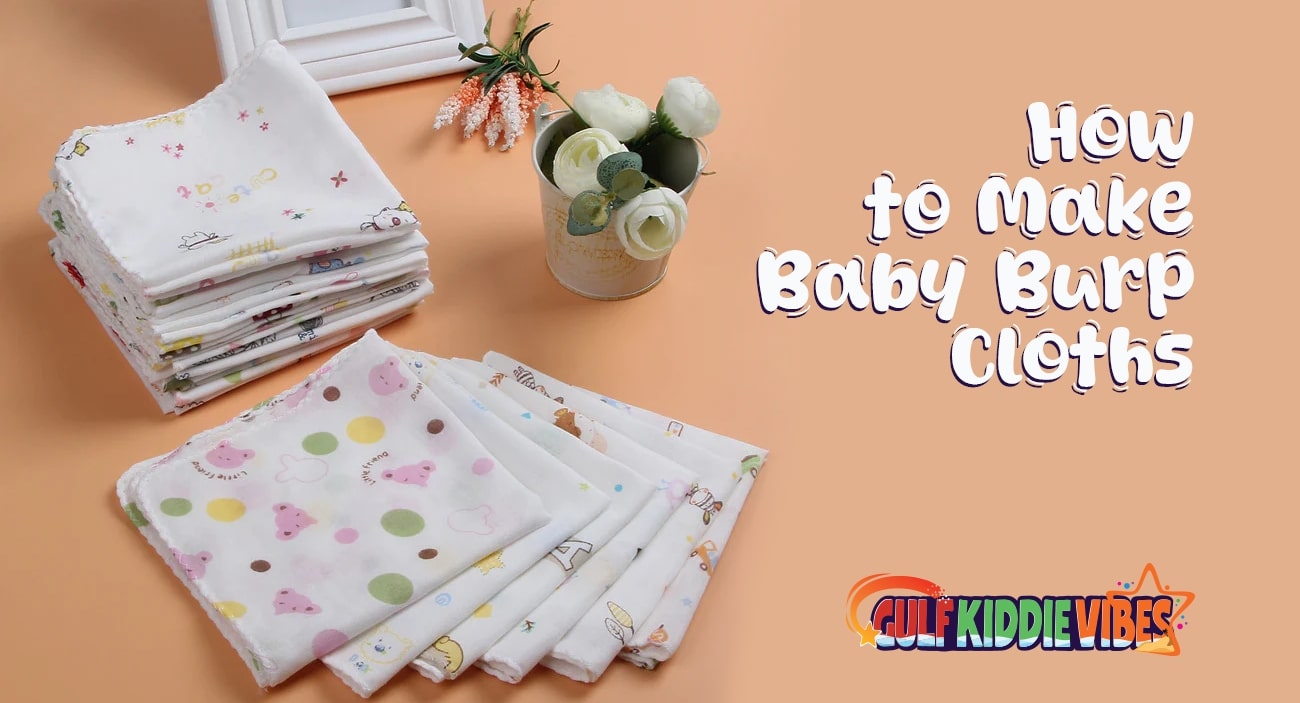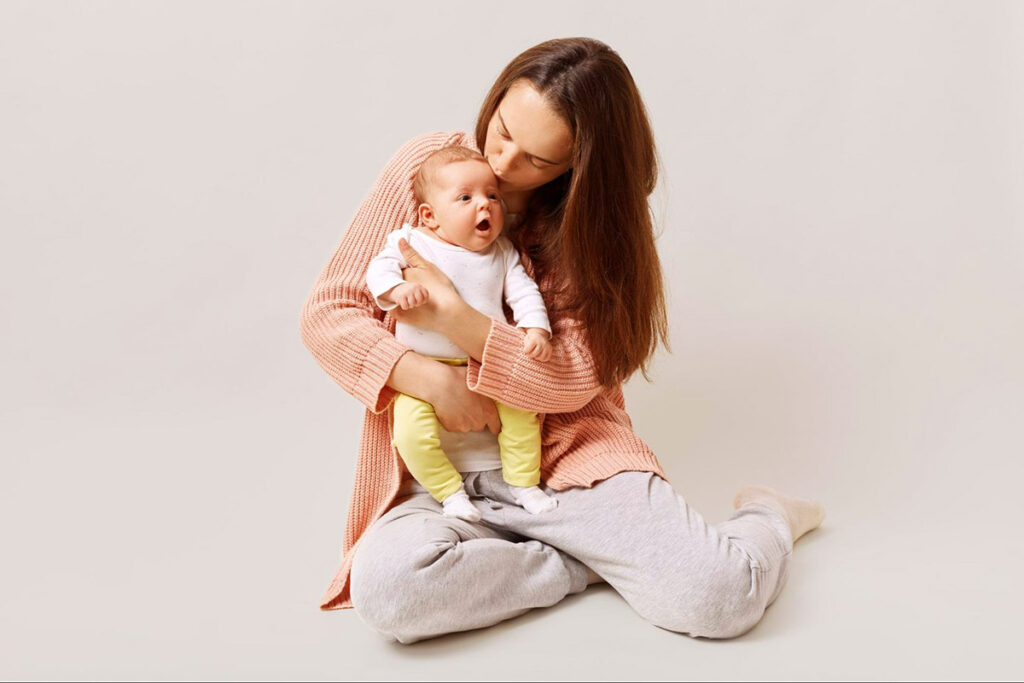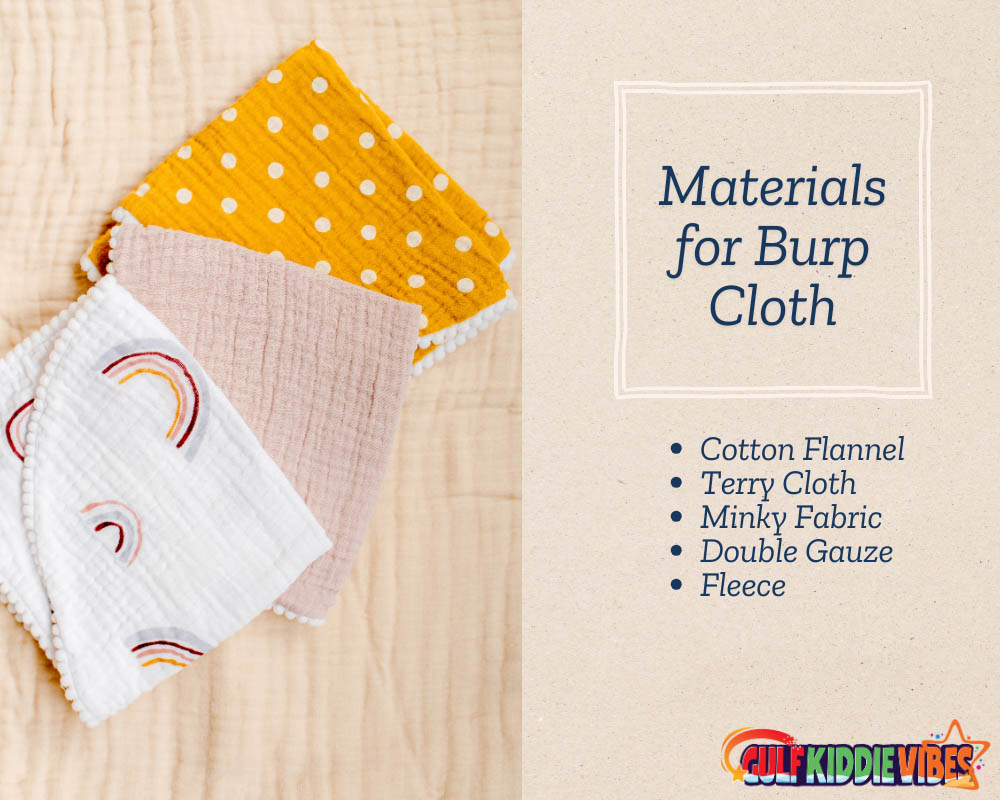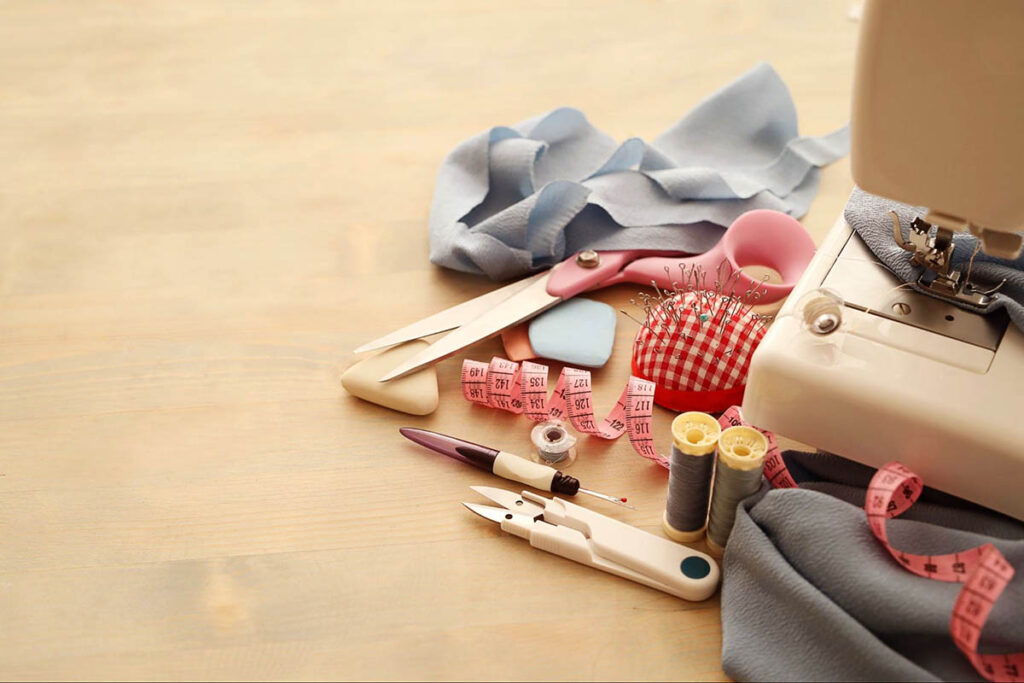
How to Make Baby Burp Cloth at Home: Step-by-Step Guide
Making a baby burp cloth at home is super simple. Here’s how to make baby burp cloth in easy steps:
- Gather your materials beforehand. You’ll need soft fabric like cotton flannel or terry cloth, sewing machine, scissors, thread, pinks.
- Cut two fabric pieces (approx. 10” x 18”).
- Wash and iron the fabric to pre-shrink it. Ironing will make it easier to sew. Lay the pieces together with the right sides facing inward.
- Sew the pieces together using a straight stitch. Sew around the edges and leave a small gap (about 3 inches) for turning the fabric inside out. Use a ¼-inch seam allowance for neatness.
- Turn the fabric right-side out through the gap, and press it flat with an iron. Topstitch around the entire burp cloth and close the gap as you sew. This also adds a polished finish.
Table of Contents
I always feel worthy whenever I make something for my baby by myself. Recently I crafted a batch of burp cloths for my baby, and it was actually easier than I initially thought.
As a mom I always feel making something for a baby at home is a fun and rewarding project. Especially for new parents. It can give them a fulfilling feeling and a memory to cherish forever. You can make clothes, mittens, beanies, or even burp clothes like me. With your love and care you can turn these ordinary items into something meaningful.
In this guide, I’ll walk you through how to make baby burp cloth step by step at home. My easy tutorial is perfect for you whether you’re a complete beginner or have some sewing experience.
Let’s sew together!
Are Baby Burp Cloths Necessary?

When you make a shopping list for your newborn you must list burp cloth. It is as necessary as swaddles, mittens, or diapers.
Babies can be messy during feeding time. And a good burp cloth helps protect your clothes from spit-up and drool. To save yourself from these little disasters, burp cloths are a must-have for any new parent. Plus, you can customize homemade burp cloths in size, fabric, and style to suit your needs and preferences.
If you are going to be a new aunt or uncle then the baby burp cloth also makes fantastic baby shower gifts. They are both practical and adorable.
Homemade burp cloths offer several advantages:
- Customizable: You must give priority to your baby’s comfort. Choose fabrics and sizes that work best for your baby.
- Durable: Try to pick excellent quality material. High-quality materials ensure they last longer than store-bought options.
- Personal Touch: You can add decorative stitches, fun patterns, or even embroidery for a unique touch.
What Material Do You Use to Make Burp Cloth?

Babies have the most delicate skin in the world. Their skin can get easily irritated if it comes near any rough fabrics or chemicals. That’s why whenever I make anything for my baby at home I give extra attention to pick the right materials. It was no different when I was making burp cloth.
The choice of fabric is not only crucial for baby’s health but also for making effective and comfortable burp cloths. Here are some excellent fabric options I think you might try:
Cotton Flannel
Cotton is one of the most friendly fabrics that suit both babies and adults. This fabric hardly shows any allergic refraction to the skin. This soft fabric is gentle on your baby’s skin. Besides, cotton is highly absorbent, making it a favorite for burp cloths. You can sew cotton flannel easily. This fabric comes in a variety of colors and patterns. So, you can make a batch of colorful burp cloth with playful patterns.
Terry Cloth
Terry cloth fabric is another great option when you are making a burp cloth. The best part of this fabric is its excellent absorbency. It’s perfect for catching spit-up and keeping your baby clean. You can use old towels or purchase terry cloth by the yard.
Minky Fabric
For my baby I always look for soft fabrics that are equally cute. I consider minky fabric for an extra soft and cozy fee. Minky fabric is not as absorbent as flannel or terry cloth. But it’s perfect for the backing layer of a burp cloth.
Double Gauze
Double gauze is my other favorite fabric. It is soft and it has a very beautiful texture and comes in beautiful colors. Double gauze is lightweight and breathable. Its thin texture is ideal for layering. It adds extra absorbency and doesn’t make the cloth too bulky.
Fleece
Although fleece isn’t absorbent, it works well as a middle layer. Fleece is durable and soft. So, it’s best to use a middle layer.
Essential Fabric Tips:
- Look for absorbent fabrics like cotton or terry cloth for the top layer.
- Choose soft fabrics for layers that will touch your baby’s skin.
- Use fabric scraps or leftover materials from other sewing projects to save costs.
How to Make Baby Burp Cloth at Home: Step-by-Step

I’ll share with you how I made burp cloth for my baby. I found these processes easy and simple.
Materials
Strat with choosing the materials. To make your own burp cloths, you’ll need the following:
- Fabric: Choose 1 yard of cotton flannel, terry cloth, or other absorbent material available at home.
- Thread: All-purpose coordinating thread.
- Batting (optional): If you want extra absorbent choose cotton batting.
- Sewing Clips: To hold fabric layers together.
- Decorative Stitching Thread (optional): For a cute finishing touch you can add decorative stitches. Choose colorful threads.
Tools
- Sewing Machine: You can use a regular sewing machine. I used a regular one, and it worked perfectly for this project.
- Rotary Cutter or Fabric Scissors: For cutting fabric.
- Seam Gauge or Ruler: To measure seam allowances.
- Iron and Ironing Board: For pressing fabric.
- Pins or Clips: To secure fabric layers.
Step-by-Step Instructions
Step 1. Cut the Fabric
You have to decide on the size of your burp cloth and cut the fabric following this size. A common size is 10” x 18”. For my baby I picked this size. But you can adjust dimensions to your preference.
Then I used fabric scissors to cut out two rectangles of fabric per burp cloth. You can use a rotary cutter as well to cut the fabrics.
Step 2. Layer the Fabrics
Layering is important while making burp cloth for absorption. Place the two fabric pieces right sides together (the side with the pattern or print facing inward).
If you want more absorbent use batting. Add a layer of batting in between for extra absorbency, if desired.
Step 3. Pin or Clip the Layers
Now that you place all the layers of fabrics, it’s time to sew. I secured the edges using sewing clips to prevent shifting while sewing. You can use pins if you don’t have clips.
Step 4. Sew Around the Edges
I used a straight stitch. I sewed around the perimeter of the fabric. I left a 2-3 inch gap on one side for turning.
For neat edges maintain a ½-inch seam allowance.
Step 5. Clip the Corners
After the sewing was done I trimmed excess fabric and clip the corners. It helps to reduce bulk when turning the cloth right-side out.
Step 6. Turn the Cloth Right-Side Out
In this step I gently turned the burp cloth right-side out through the gap I left earlier. I used a tool like a chopstick to push out the corners. It gave the burp cloth a clean finish.
Step 7. Press and Topstitch
In the final step, I pressed the edges flat with an iron. I closed the gap by sewing a topstitch around the entire edge of the burp cloth. You can use decorative stitches for an added touch.
Optional Finishing Touches:
- Add decorative stitching along the edges for a polished look.
- To make the burp cloth more charming use fun prints like character fabric or adorable snuggle flannel fabric.
Related: How to Organize a Newborn Dresser: An Expert’s Guide
How Many Burp Cloths Does a Baby Need?
As a mom I quickly realized how essential burp cloth is in my daily routine. As babies’ digestive systems are still developing in the first few months they spit up more often. So, as my baby is still little I’m needing burp cloth constantly. During feedings, burping, and even random moments throughout the day burp cloth is helping me.
- Newborns: 8-12 burp cloths per day.
- Infants: 6-8 burp cloths per day.
If your baby spits up a lot (like mine did during the first couple of months), then you should stock up on even more burp cloth. Stock up on closer to 15 or 20. Babies can go through several in a single day, especially if they’re having a fussy feeding day or dealing with reflux.
Can I Use a Towel as a Burp Cloth?
I used a towel for the first 2 months and it worked well. Towels, especially inexpensive bath towels or kitchen towels, are excellent alternatives. I cut them into smaller pieces. Then I hem the edges. In this way you can have some practical burp cloths for your baby.
I’ll admit, I wasn’t sure how well it would work at first. But after a few messy feeding sessions, I realized towels can actually be quite handy for certain situations.
One evening, my baby had an unusually fussy feeding and ended up spitting up a lot more than usual. I used the small burp cloth but it wasn’t enough to handle the mess. I grabbed a soft kitchen towel, draped it over my shoulder, and—problem solved! Surprisingly, it was larger and more absorbent. It covered more of my clothes which was a lifesaver.
If you are using towels instead of burp cloth then choose the one made of cotton or terry cloth. They are designed to soak up moisture. They are perfect for handling those big spit-up moments when a regular burp cloth might not be enough.
How Many Burp Cloths Do I Need Per Day?
This depends on your baby’s feeding habits. Most parents find they go through 6-10 burp cloths daily. Making a large batch ensures you’re never caught without one.
The number of burp cloths you’ll need per day really depends on your baby and their feeding habits. Some babies spit up a lot, while others rarely do. For me, with a baby who had mild reflux I’m using about 5 to 6 burp cloths a day during the early months.
Is Cotton Good for Burp Cloth?
Cotton is an excellent choice for burp cloths. From my personal experience, it’s one of the best materials you can use. As a parent, I’ve tried different fabrics for burp cloths, and cotton always stood out. This fabric is comfortable and practical, and has great absorbent power.
Babies have delicate skin. So, anything rough or scratchy can irritate them. As cotton is naturally soft and breathable, it’s perfect for wiping the baby’s face or resting on their tender skin during feeding or burping.
Burp cloths go through constant washing, and cotton holds up remarkably well. After multiple cycles in the washing machine, my cotton burp cloths remained in great shape, whereas other fabrics like polyester blends tended to lose their softness or absorbency over time.
How to Burp a Newborn: Different Burping Positions
Burping your baby is crucial after feeding to release trapped air. Here’s how to do it effectively:
1. Over-the-Shoulder Method
- Place a burp cloth over your shoulder.
- Hold your baby upright, resting their chin on your shoulder.
- Gently pat or rub their back.
2. Sitting on Your Lap
- Sit your baby on your lap, supporting their chest and chin with one hand.
- Pat their back with your other hand.
3. Lying Across Your Lap
- Lay your baby tummy-down across your lap.
- Pat their back gently until they burp.
Frequently Asked Questions (FAQs)
Question: What is the Difference Between a Burp Cloth and a Washcloth?
Answer: A burp cloth and washcloth look similar but they have different purposes. A burp cloth will save your and your baby’s cloth from spit-ups when you burp them after a feeding. On the other hand, a washcloth is smaller and softer than a burp cloth. Parents use a washcloth for cleaning the baby while bathing or cleaning up gentle spills. Burp cloth is usually made of absorbent materials like cotton, flannel, or terry cloth. Washcloths are made of soft and durable fabric like cotton. Burp cloths are larger in size and focus on covering a shoulder or lap.
Question: At What Age Can I Stop Burping My Baby?
Answer: You can stop burping your baby between 4 to 6 months of age. Though this varies depending on their development and feeding habits. Around this time, babies start sitting up and can better manage swallowing air during feedings. At this age babies become more efficient at eating. That reduces the likelihood of gulping too much air.
However, some babies may still need occasional burping beyond 6 months, especially if they are prone to gas or spit-ups.
Question: Do I Need to Wash Burp Cloths Before Use?
Answer: You always have to wash burp cloth before using. You must wash them if they are brand new or used once. If they are new then burp cloths often come straight from factories or stores. So, there is a chance they might have been exposed to dust, chemicals, or bacteria. Before using the burp cloth you have to make sure they are clean and safe. For cleaning your baby’s clothes or accessories use a gentle and baby-safe detergent that doesn’t include harsh chemicals or fragrances. In that way you can reduce the risk of irritation or allergic reactions.
Question: How Many Months of Burping is Necessary?
Answer: You need to burp your baby for the first 4 to 6 months. This is the most crucial time when babies are most prone to swallowing air during feelings. It happens especially if they are bottle-fed or are fast eaters. If you burp regularly during and after feeds that can help release trapped air. It will reduce discomfort, spits-us or gas pains of your baby.
Conclusion
Doing something for a baby, especially making anything at home by myself is always a rewarding experience for me. Making baby burp cloths at home is simple yet meaningful.
By choosing the right materials and following these easy steps, you can create those practical, durable, and adorable burp cloths for your baby. Or you can give a gift to any new mom as a thoughtful handmade gift.






